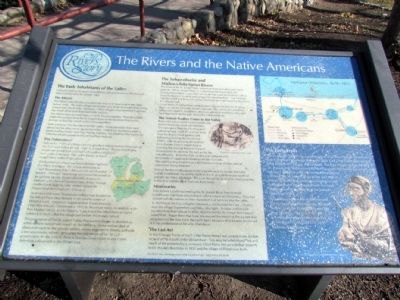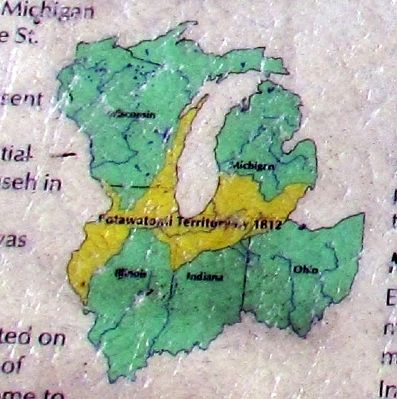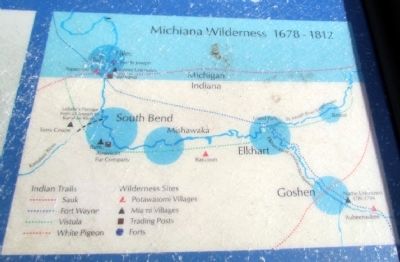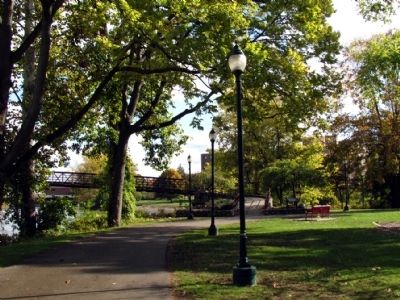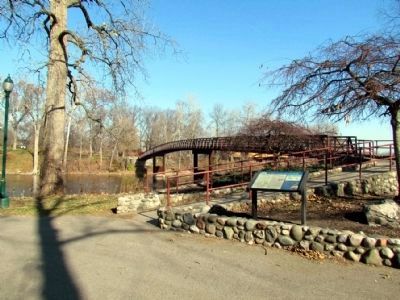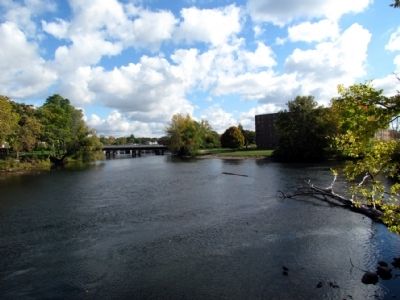Elkhart in Elkhart County, Indiana — The American Midwest (Great Lakes)
The Rivers and the Native Americans
Our Rivers' Story
The Early Inhabitants of the Valley
Centuries before the area was settled by whites, at least two different native tribes inhabited the St Joseph Valley.
The Miami
The Miami were the first recorded tribe known to have lived in the valley before 1668. The main village was located east of the St. Joseph River at the present day site of Niles, Michigan. Other villages were recorded in present day South Bend and Waterford Mills, Indiana.
The Miami were present when, in 1678, French explorer, Sieur de LaSalle, made the portage from the St. Joseph River to the Kanakee River on his journey to find the mouth of the Mississippi River.
Little is known why the Miami left the valley. Some speculate they were driven out by other more aggressive tribes. Others say they sought a better trading center near Fort Wayne, Indiana. For whatever the reason, by 1706 the Miami ceased to inhabit northern Indiana.
The Potawatomi
Early in the 1700's the Potawatomi began their migration from Wisconsin to the St. Joseph Valley by way of the St. Joseph River. This band of native Americans spread out over much of southern Michigan and northern Indiana. They were known as the St. Joseph River Valley Potawatomi.
The best known village was located west of present day Niles, Michigan. This village was home to Chief Topenebee, one of the area's most influential leaders. Although Topenebee had joined Tecumseh in an uprising against the white settlers, there is no indication that he ever harmed them. In fact, he was credited with helping some settlers survive the Massacre of Fort Dearborn (Chicago).
Another well-known Potawatomi village was located on the Elkhart River near Benton in the southern part of Elkhart County. Known as Aubeenaubee, it was home to Chief Five Medals. Destroyed in 1812 by American troops in retaliation for Five Medals' attack on Fort Wayne, it appeared the inhabitants escaped unharmed, having fled the village just before the troops arrived.
The population of the St. Joseph Valley Potawatomi began to diminish as white settlers moved westward into the territory. Some natives died of disease brought to the area by settlers, others migrated to Illinois, and with a few exceptions, others were being forcibly removed by the U.S. government. By the 1830's, there is little documentation of any native American villages left in the Elkhart area.
The Sohgwohsebe and Mishiwa-Teki-Sipiwi Rivers
The rivers in the St. Joseph Valley played an important role to the native peoples. The St. Joseph River, or as the Potawatomi named it, the Sohgwohsebe River, was a migration route that could be traveled north to Lake Michigan
or south by portaging to the Kanakee River. The Mishiwa-Teki-Sipiwi (Elkhart River) served as a landmark to establishing the important Fort Wayne Trail.
As we know, all settlements needed water sources not only for drinking purposes, but for food and shelter materials. These rivers provided fish, turtles and crawfish. In addition, the rivers attracted waterfowl, deer and bear that made up the daily diet of the valley residents.
The French Traders Come to the Valley
Before the arrival of the French traders, the Native Americans were self-sufficient. The men spent their days hunting and gathering food, while the women were busy tending to small gardens and fashioning clothing. But by the late 1600's, with the growing demand for fur in Europe, French traders began traveling the rivers to barter trinkets or hard-to-come-by items to the natives for valuable pelts. Soon this daily routine was replaced with the priority of trapping fur-bearing animals for trade. This over-hunting would have a detrimental ending with the animal population being depleted.
One of the first trading posts in the area was built by Joseph Bertrand. Joseph established the post in 1808 on the St. Joseph River just south of present day Niles, Michigan. The post thrived because of its close proximity to the river and the Sauk Trail (see Early Trails).
Missionaries
Even
before LaSalle traveled up the St. Joseph River, French Jesuit missionaries had been converting the Potawatomi to Christianity. They had moved with the natives as they expanded their territory into the valley. In 1823 Isaac McCoy, a Baptist Missionary, established the Carey Mission near the village Topenebee and Niles, Michigan. As Isaac and his wife traveled from Fort Wayne to Niles, they forded the St. Joseph River east of Island Park. It was there that Isaac discovered the mouth of the a creek that emptied into the river from the north bank, because of its beauty, he named in in remembrance of his wife, Christiana.
The Last Act
In the Chicago Treaty of 1821, Chief Pierre Moran was awarded one section of land at the mouth of the Elkhart River. This area included Island Park and much of the present day downtown. Chief Pierre Moran sold that property to Dr. Havilah Beardsley in 1831 and the village of Elkhart was born.
Topics. This historical marker is listed in these topic lists: Colonial Era • Native Americans • Settlements & Settlers • War of 1812. A significant historical year for this entry is 1668.
Location. 41° 41.51′ N, 85° 58.193′ W. Marker is in Elkhart, Indiana, in Elkhart County. Marker can be reached from Pacific Street west of N. Elkhart Avenue. Marker is located on Island Park; you
may park on Pacific Street in Lundquist Bicentennial Park and walk across the pedestrian bridge to the island. Touch for map. Marker is in this post office area: Elkhart IN 46514, United States of America. Touch for directions.
Other nearby markers. At least 8 other markers are within walking distance of this marker. The Rivers for Recreation (about 300 feet away, measured in a direct line); The Rivers for Industry (about 400 feet away); Village of Pulaski (about 500 feet away); Island Park (about 700 feet away); Ruthmere (approx. 0.2 miles away); The Rivers for Commerce (approx. 0.2 miles away); Development of Diagnostic Test Strips (approx. ¼ mile away); C.G. Conn Company (approx. ¼ mile away). Touch for a list and map of all markers in Elkhart.
More about this marker. As stated on the marker, the markers for Our Rivers' Story were designed and written by James Faigh, J. Faigh Design, Elkhart, IN.
Credits. This page was last revised on June 16, 2016. It was originally submitted on October 27, 2013, by Duane Hall of Abilene, Texas. This page has been viewed 1,352 times since then and 119 times this year. Photos: 1, 2, 3, 4, 5, 6. submitted on October 27, 2013, by Duane Hall of Abilene, Texas.
